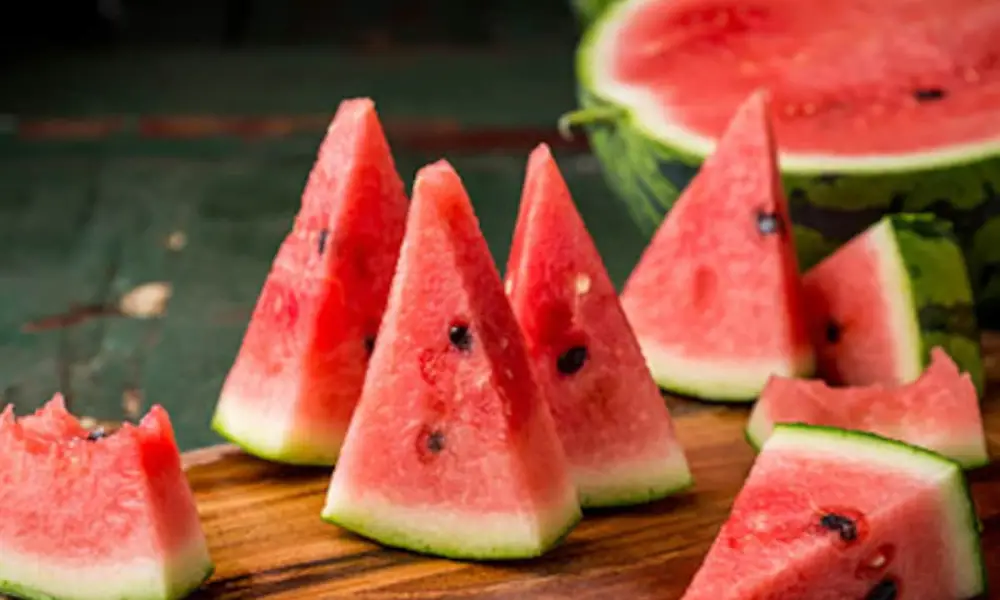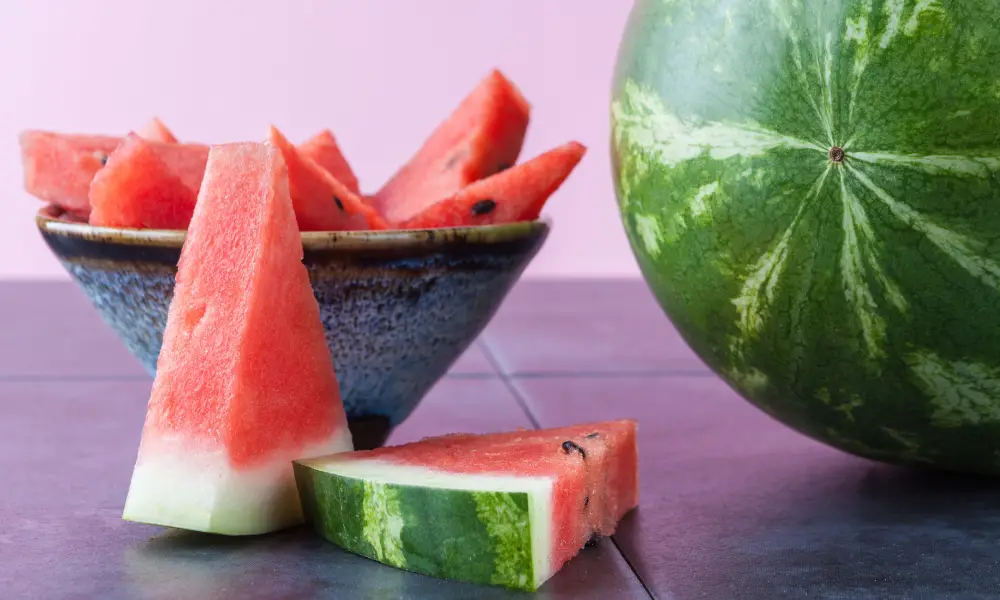Watermelon is a seasonal fruit that is most delicious when it’s partially frozen. This method keeps the fruit crisp, while also maintaining its texture. The resulting consistency is more reminiscent of a puree than a soft, mushy mass. It also keeps the water content in the melon low enough to avoid a runny consistency.
Watermelon can become over-ripe before you can enjoy it, and if you thaw it, the flesh will be mushy and bland. However, when left partially frozen, it will retain its firm texture, which is ideal for creating frozen desserts, drinks, and treats. You can even freeze chunks of watermelon to create fruity ice in popsicles or smoothies.

How to Freeze Watermelon
Watermelon Cleaning and Cutting
The watermelon should be washed and dried under running water. Before cutting into the fruit, rinse it to remove debris and dirt. If necessary, you can remove tenacious dirt with a clean vegetable brush. After that, use paper towels to pat it dry. To avoid contaminating the fruit, wash your hands with soap and hot water as well.
Use a sharp knife to cut the watermelon into quarters. Lay the watermelon out on a stable, level surface like a tabletop or cutting board. First, divide the watermelon in half, and make a side-to-side cut. After that, split the halves in half vertically by laying them flat.
Cutting the watermelon into thin slices is another method of dividing it. First, cut it in half, then slice it horizontally into pieces that are approximately 1 inch (2.5 cm) thick.
Before slicing into the fruit, you can also remove the rind. So that you can stand the watermelon up, cut off one end. The rind should then be gradually removed from all sides.
The watermelon slices should be free of the rind and seeds. Once more, arrange the pieces flatly on your cutting surface. To separate the rind from the fruit, slide your knife between the pink meat and the outer layer of white and green skin. Remove any black seeds and discard them before chopping the remaining fruit.
The rind has numerous nutrients and uses, yet you can throw it away if you don’t want to. Try cooking it, pickling it, juicing it, or adding it to a dish like stir fry, for instance.
Cube the fruit into 1 in (2.5 cm) squares. You won’t have much trouble slicing the remaining fruit into the desired size once the rind has been removed. The simplest items to manufacture and freeze are cubes and balls. To ensure that the pieces freeze at the same rate, try to keep them all at nearly the same size. Use a melon baller to create melon balls. It resembles an ice cream scoop in certain ways. After cutting the entire watermelon in half, you can utilize it.
Slices and wedges of watermelon can be frozen, however, they usually take up a lot of room. They are undesirable when consumed raw since they will lose their texture in the freezer.
You may also freeze watermelon juice or puree to make ice cubes or juice in a container. Fruit should be blended and strained before freezing.
Watermelon Dry and Unsweetened Packaging
On a baking sheet, spread the watermelon chunks out. To stop the watermelon from adhering to the baking pan, cover it with a piece of parchment paper. Make sure to keep the pieces in a single layer and to keep them from touching. Although you can put the watermelon chunks straight on the oven pan, using parchment paper or a baking mat will lessen some of the mess.
The watermelon chunks can freeze together if any of them come in contact and making it more difficult to store and defrost them later.
When the watermelon is firm to the touch, freeze it for two hours. Set a timer and move the baking sheet to the freezer. The watermelon pieces will feel frozen firm when they are ready. Give them additional time to freeze through if you can press into them with your fingertips. Use a strong spatula to remove the frozen watermelon from the baking sheet if you’re having problems. Usually, the heat from your hands is sufficient, but giving them a minute to sit outside the freezer may help them loosen.
Place the pieces in freezer-safe containers with labels. Put each component in its own plastic bag or airtight container. In case the watermelon swells, leave about 12 in (1.3 cm) of empty headroom at the top. Then, write the current date on the bag’s label so you can determine how long it has been in storage.
It’s crucial to clear your head. Without the extra room, the watermelon’s expansion could cause the container to break.
With a black marker, you can write the date right on the bags. Try using stickers as labels for containers.
The watermelon pieces can be frozen for up to a year. At 0 °F (18 °C), watermelon chunks may often be stored frozen forever. But after just 10 months of storage, the fruit’s quality will start to deteriorate.
This method of freezing watermelon causes some sweetness to be lost during preservation. In smoothies and other recipes, it works best as a liquid ingredient.
Before using, let the watermelon pieces defrost in the fridge. Put the watermelon container in the fridge when you’re ready to use it. Add the pieces to your dish after allowing them to re-soften. Especially if you intend to make a liquid out of them, like a smoothie, you may often utilize them before they fully defrost.
In the refrigerator, defrosted watermelon can keep for about 4 days. If it becomes too soft, develops moldy green blotches, or starts to smell rancid, throw it away.
What is the Nutritional Content of Watermelon?
Carbs
With very little fiber, the carbohydrates in watermelon are largely sugars. Half of the sugar is made up of fructose, 25% of the sugar is made up of glucose, 25% of the sugar is sucrose, and the other minor fractions are made up of other sugars. If you’re figuring out how much carbohydrates are in Watermelon, you must measure it precisely.
Watermelon’s glycemic index (GI) is 76.2, which means it may cause your blood sugar to rise more quickly than meals with a lower GI. However, when you consider how much you eat in each serving, a half cup of sliced watermelon has a glycemic load that is regarded as mild.
Fats
Similar to other melons like cantaloupe and honeydew, watermelon has a little amount of fat. The majority of the fat is made up of polyunsaturated fatty acids, with the remainder being monounsaturated and saturated fatty acids.
In terms of diet, watermelon can be regarded as a fat-free food. Seeds contain omega-3 fatty acids (which are edible).
Protein
Only 0.6 grams of protein per 100 grams may be found in watermelon. It’s interesting to note that some businesses sprout and shell watermelon seeds to produce protein.
Fresh seeds, however, do not have that level of protein because the seed’s shell prevents the internal protein from being digested.
Vitamins and Minerals
A red watermelon that is fully ripe has more nutrients than one that is not as ripe. A single serving of watermelon can fulfill a significant percentage of your daily needs for both vitamin C and vitamin A.
While vitamin A is essential for eye health, vitamin C aids in wound healing and may have anti-aging and immune-boosting properties6.
Calories
Sliced or balled watermelon contains roughly 30 calories per 1’00 gram. If you like to eat it wedged, a wedge that is around one-sixteenth of the melon has nearly twice as many calories, or about 86.
Reference: Watermelon (Citrullus lanatus (Thunb.) Matsumura and Nakai) seed oils and their use in health
What are Watermelon Serving Suggestions?
Juice: To prepare a cool, revitalizing electrolyte drink perfect for rehydrating after a day in the heat, blend sliced watermelon with a few ice cubes.
Salad: Combine watermelon, mint, and fresh mozzarella on a bed of spinach leaves to produce a delicious and nutritious salad. Add a balsamic vinaigrette drizzle.
Smoothies: Add orange juice for a tangier flavor or blend in some watermelon. The fiber is broken down by juicing, which makes it easier for the sugar to be absorbed. People with diabetes should eat instead of drinking juice.
Roasted Seeds: Roast the watermelon seeds for 15 to 20 minutes to make a tasty snack. Around 8 g of protein, or 14–17% of the daily requirement, can be found in one ounce (28.5 g) of seeds.
Can You Eat Watermelon Every Day?
If eaten in moderation, watermelons shouldn’t have any noticeable negative consequences. However, let’s say you regularly eat a lot of fruit. Then you can experience problems as a result of having too much potassium or lycopene. Since watermelon contains 92 percent water, it’s a great option for daily hydration. This melon also has a low-calorie density, or a low number of calories per unit of weight, due to its high water content.
More than 30 mg of lycopene per day may induce nausea, diarrhea, indigestion, and bloating. By keeping you feeling full for longer, low-calorie foods like watermelon, for instance, may aid in weight loss.
Does Watermelon Have a High Sugar Content?
One of the most well-known summer fruits is watermelon. Despite their appearance, they contain little sugar. Less than 6 grams of sugar are present in 100 grams of watermelon. The fact that watermelon is a good source of iron is an additional bonus. Diabetes sufferers can have watermelon in moderation without getting sick. On the other hand, meals that are rich in fiber, protein, and healthy fats should be consumed together with watermelon and other fruits with a high glycemic index (GI).
How Does Watermelon Affect Diabetes?
Diabetes sufferers can have watermelon in moderation without getting sick. On the other hand, meals that are rich in fiber, protein, and healthy fats should be consumed together with watermelon and other fruits with a high glycemic index (GI). What is the recommended daily intake of watermelon for diabetics? “Watermelon has a low glycemic load since it contains 70% to 80% water,” People with diabetes can eat 150-200 gm amounts of watermelon. In moderation, bananas are a healthful and nutrient-rich fruit that persons with diabetes can include in a balanced, individualized diet plan. In a diabetic’s diet, fresh, plant-based foods like fruits and vegetables should be consumed. Bananas are a healthy food source that doesn’t have many calories.
Conclusion
Watermelon may be kept on hand all year round by freezing. Dry freezing watermelon on a baking sheet is the simplest method for accomplishing this. To retain some of the sweetness lost while freezing, you can add sprinkled sugar to the watermelon. Store watermelon in syrup or fruit juice to keep it as sweet and fresh as possible. Watermelon may still be eaten or used in smoothies and other dishes even though freezing does cause some of its natural texture to disappear.
